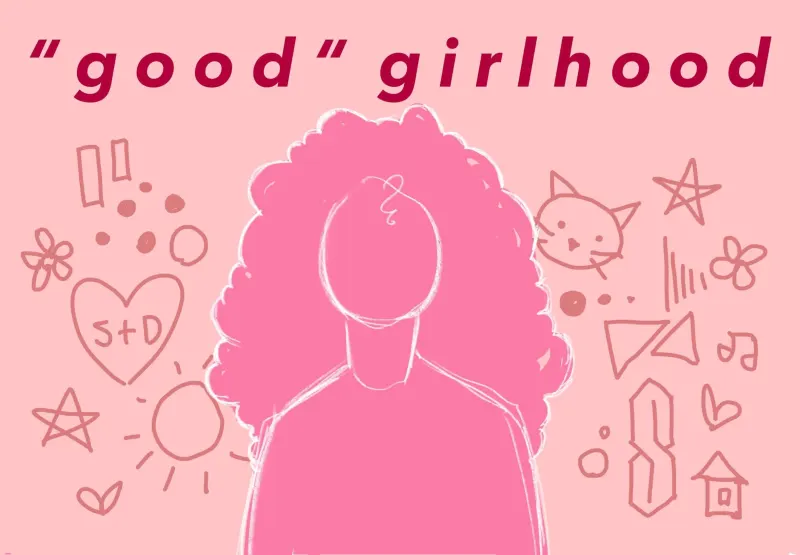In her column “‘Good’ Girlhood,” Blyss Cleveland reviews female-centered coming-of-age films. This article is a review and includes subjective thoughts, opinions and critiques.
While Leo Tolstoy wrote the iconic opening line in “Anna Karenina” in 1878, “All happy families are alike; each unhappy family is unhappy in its own way” remains relevant a century down the line.
The “Slums of Beverly Hills” (1998) opens with a title card with this quote. Lest the viewer believes this is dramatic irony, the camera cuts to protagonist Vivian Abromowitz (Natasha Lyonne), who is meditating on this maxim and waiting to be fitted for her first bra. In the background, her father Murray (Alan Arkin) and a saleswoman discuss her growth spurt, while she is not even in the room. Written and directed by Tamara Jenkins, the semi-autobiographical feature film charts Vivian coming to terms with her working-class family’s precarious mobility. If her family is unhappy, can she learn to be content with its brand of dysfunction?
The comedy drama takes place during the summer of 1976. Instead of spending the dog days of summer sleeping in, Vivian, Murray and her two brothers, Ben (David Krumholtz) and Rickey (Eli Marienthal), serve as four-person impromptu moving crew. Murray is a single father who is singularly focused on maintaining an address in Beverly Hills to ensure his children can access good schools.
This obsession means a constant rotation through dingbats, low-rise apartment buildings characterized by cheap rent and misleading names like “Casa Bella.” Rickey suggests that if they move to a cheaper neighborhood, they would be able to afford furniture. Murray’s response? “Possessions are temporary, but education is permanent.”
Murray is a car salesman who secures extra cash by enduring lectures from his more successful brother. The Abromovitz family’s fortune changes dramatically when Rita (Marisa Tomei), Vivian’s 29-year-old aimless cousin, escapes from a rehab facility. Murray agrees to take in Rita to keep her out of trouble and help her find some direction, as long as Rita’s father is willing to front the cost of having an extra mouth to feed.
Rita’s entry into the Abromovitz fold is supposed to provide a woman’s perspective for Vivian. Rita is as liberal with her body as Vivian is restrained, but Rita’s constant motion doesn’t translate into momentum for her own life. Rita seems to have gotten to the other side of girlhood through learning to preempt outsider critiques through self-criticism.
Vivian is surrounded by characters marching to the beat of their own drums, and it is delightful to see her let loose. In one scene, Rita introduces Vivian to her boyfriend (a vibrator) and they begin to dance while tossing the device to one another. When they are interrupted, Vivian is in possession of the device and goes into panic mode as she tries to turn it off. Thankfully, this experience does not deter her from finding an even more pleasurable use for the device.
In addition to the constant surveillance and commentary on Vivian’s body, various scenes suggest that being poor means careful maintenance of objects that affluent people get to possess, use and enjoy. When a neighborhood boy takes an interest in Vivian, he is more interested in her than she is with him, but she seizes the opportunity to hook up with him without strings attached. Constant objectification has made it so that sexual intimacy is a series of boxes to be checked.
In addition to figuring out how to be in full possession of her body, the story forces Vivian to confront how an outsider’s view of her family shapes her internal understanding of who they are. When her brothers insist they are poor, she denies this label because they aren’t “regular” poor. After Rita joins their household and they move into a luxury apartment, Vivian tries on “middle middle class” and bourgeois. No matter which label is applied, witnessing a boundary violation changes her opinion of herself and makes her temporarily feel as if she is the product of an irredeemable environment.
The Abromowitz family’s existence is used as a metaphor for Jewish identity. Murray’s obsession with education may exasperate his children, but he is acting on diasporic wisdom. As a group of people with a history of displacement, knowledge has been the only thing they could take with them. Throughout the film, they take turns storytelling. From lore about Murray’s time as a thriving entrepreneur to tidbits of gossip about the celebrity inhabitants of their neighborhood, narrative is the tool that allows them to remember where they came from and imagine a better future.
Lyonne is best known for her work on Netflix series’ “Orange is the New Black” and “Russian Doll,” and it is a joy watching her in this indie cult classic. She has the challenging task of being the straight woman, where much of the comedy comes from the other character’s outsized reactions to completely normal occurrences. When Vivian has a major outburst, it is as funny as it is painful for the target of her ire because Lyonne telegraphs the shock and exasperation that she has mostly hidden throughout the film.
If there must be unhappy families, maybe the key to episodes of contentment is learning to take turns having meltdowns and synchronized outrage at an outside target.
